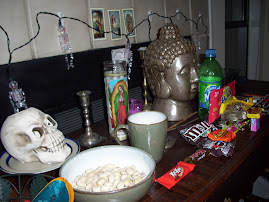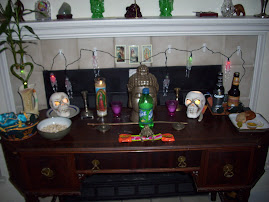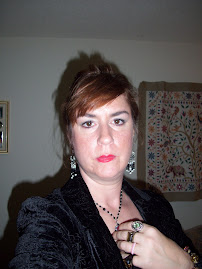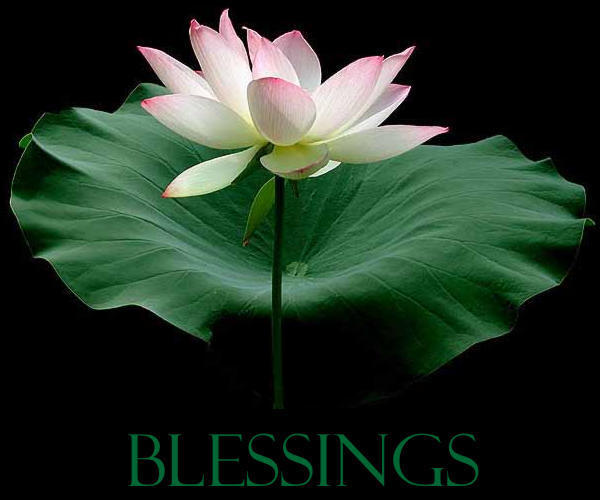Wednesday, November 19, 2008
Monday, November 3, 2008
Dancing with the Dead-My El Dia De Los Muertos Experience
I can tell you that I felt an extreme sense of peace and comfort just like I would if I had a house full of my most favorite relatives and friends. It was a family reunion of souls, for sure. I felt an energy shift on November 2nd when supposedly all the dead return to their heavenly home. Things seemed very special indeed around here, now I have a cool new holiday to share with my son. Ian was really open minded and put his own Ofrendas on the altar, including Halloween toys and more candy and soda! I decided to dress up like Frida Kahlo to honor her memory. I have enjoyed getting to know her through her incredible artwork, I feel as if she's a friend. Hopefully she was one of my "visitors", since I feel a good connection with her. My grandmother was always the one to create new traditions in our family, and I believe this weekend her legacy was somehow passed on to me, the first grandchild. I am glad to have a new and unique tradition that I will add to each passing year, and to pass on to my son and future grand kids!
Monday, October 27, 2008
Folk Tales of Ireland
The "King of Ireland's Son" was an interesting happily ever after the gore fairy tale. It was loaded with typical fairy tale elements, such as giants at every stopping point, and a little green leprechan man, who was essentially in control of the whole show. The typical children's fairy tale of our time does not elude to violence like this tale does. The little leprechan intimidates and scares the giants by telling them that he will be beheaded by his master who is an enormous giant himself. It's funny to me how the king of Ireland's son, who is not named or called a prince proper, wants to travel afar to the east to marry a blood thirsty woman. Its not about love and happily ever after necessarily, but rather contest and conquest, and adventure.
The "Birth of Finn MacCumhall" was somewhat of an epic of pain and suffering and tragedy that ends up in victory. This tale includes alot of gore and mayheim and seems relentlessly barbaric to me. This is the price to pay for triumph in the end, for Finn ends up with the King's reverence and respect and inherits the Dunn.
Significant, in all these tales, is events themselves alude to the passing of time, rather than increments of time, such as minute, hour, days, and years. Night to Dawn seems to be the most used reference point, in terms of when the events occur. Supper time is also another reference point, instead of evening. Time is rather vague, for phrases such as "a long time ago", "in those days," do not denote exact passages of time. It isn't obvious either when exactly the tales are set. Some are written in the 1900's, others in the 1800's. It seems the tales could go back to Biblical times, like B.C., or perhaps the 1400's. They appear to be as old as the days, and could date back to the beginning of Ireland, I suppose. In the tale of "The Man Who Had No Story", there are almost maybe two evenings worth of events in one night's slumber, or perhaps longer, because Brian went to the Fairy Glen at lunch, which could have been noon or early afternoon. I think time is vague perhaps because it is not so much the time as it is the journey. Hard to fathom, considering how we are such slaves to time clocks, due dates, appointments, and when things are "supposed" to happen. I think Europe in general is more laid back about time.
Thursday, October 16, 2008
Impressions of Kyogen
Kamabara appears to be a lovers quarrel. There is a shrew of a woman dressed in white with a spear chasing around her insubordinate mate, threatening to beat him to death. The other guy is stuck in the middle and attempting to mediate between the two. This scenario goes on until the mediator chases the shrew off the stage. The rest of the play is a soliloquy of the heartbroken lover threatening to kill himself, which turns into a futile and hilarious attempt to kill himself by tying a knife to a post (a tree) so he can fall into it. The soliloquy is melodramatic which makes it funny in a wiry way. I never really burst out laughing like in crab mask, but rather grinned the whole way through it. The soliloquy was a great tool for the lover to process his hurt which ended up turning into anger at the woman, for he decided he would kill her instead. As he exits the stage, one is given the impression he is hallucinating. This play turns a serious lovers quarrel into a farce. The Shakespearean Soliloquy served as a way for the viewer to get insight into the character's innermost emotions. This play reminded me a lot of Hamlet. "To be or not to be, that is the question," from the deeply serious Hamlet is analogous to the line from the farcical Kamabara ," A man is a man even if he is made of bundles and bundles of worthless straw." The Soliloquy in Kambara was likewise an opportunity for the character to vent his feelings and move past the desire to kill himself. This play is turning a possible real life tradgedy into a comedy. Kyogen is healing because if one can find humor in serious situations, life is easier.
Monday, October 6, 2008
Japan revisited
Monday, September 29, 2008
Hotel Rwanda
It is shocking and amazing to me how the UN had very few soldiers--less than 300 for the whole country. Paul points out in the movie that the only thing keeping them is alive is that they are on Belgian property. Paul is able to use his connection to the parent hotel the Sabena to his advantage to be able to house the 1200 refugees. In spite of the ethnic war between the Tutsis and the Hutus, I could not see much difference between the two cultures. They speak the same language, have strong family values, and intermarry. In fact, Paul is Hutu and his wife Tatiana is Tutsi. The Belgians a long time ago referred to the Tutsis as tall and elegant and superior to the Hutus, and favored them. For years the Hutus and Tutsis have been at war and the power has shifted several times between these two groups. I believe this would have never happened if control by the Belgians would have never taken place. Even after Rwanda was independent, the roots of destruction had already taken a strong hold.
It is also significant that Americans can hear about the horrors of Rwanda and go on "eating their dinners." In fact, the UN never declared this situation in Rwanda genocide, which would have allowed for more intervention. Supposedly Clinton apologized in 1998 for not taking more responsibility for helping. Colin Powell acknowledged the genocide taking place in Darfur, but only a force of 800 troups have been dispatched as peace keepers and cannot open fire except in self defense. This movie is a poignantly revealing of what is happening all over the continent in the 21st century, perhaps threatening to exterminate traditional African culture altogether. I hope the next president of the US will maybe place more importance on human rights rather than emphasize deploying more troups to Iraq.
I think the movie showed some elements of what remains of African culture, as evidenced in the poolside dance and the Hutu shirts and turbans worn by the Hutus. However, the point of the movie is to depict what is really going on and to increase the awareness of this. The bodies covering the road as Paul drives the hotel van over them and showing the Tutsis getting slashed by machetes and the forshadowing of the machetes falling out of the beer crate in the beginning of the movie depict to a small degree of how horrific those 3 months really were. I cried the whole way through the movie because of the horror and because of how moved I was by Paul's bravery and smarts in saving 12oo. It is an example of how the desire for control and power can perpetuate to hate and finally undignified bloodshed. The seeds for this destruction were planted a long time ago when the European domination occured decades ago.
Wednesday, September 24, 2008
Early experiences of Dance
I think of Mama Africa as a Continent, as one whole. There are different countries within the continent, of course. When I think of Africa, I think of the diversity of the creatures and the many terrains. I see beautiful prides of lions, antelopes, bison, primates of all sorts, Gorillas in th mist, trees with leopards eating their prey, huge vultures, etc. I see many glorious colors of costumes, gorgeous women and men wearing elaborate dress. I see many and varied masks representing spiritual entities and animals. There are different types of drums, with unique tones, voices , and sizes. I see Pygmies, Bushmen, and Modern Man alike. I think I should visit sometime.
Friday, September 19, 2008
random musings of cultural awareness
In my experience over the last five years as a energy and bodyworker, I have been into eastern thought pertaining to philosophy and medicine. There are two main differences between Chinese and Western allopathic medicine. The Chinese look at the mind body and spirit as one whole, whereas Western medicine has had a tendency to compartmentalize the mind body and spirit as well as the organ systems of the body. For example, if you go to an acupuncturist for treatment for stomach problems, you will not be prescribed a pill to control the acidity but rather your whole body will be treated, because all the organs "communicate" and influence each other and if one organ is unhappy it will affect the function of other organs. So, if the energy (refered to as Chi) is not flowing freely thru one organ, it is in effect "blocked", the other organs are in a Chi deficit because the other organ system is holding up the chi. Thus, the energy is not freely flowing and available throughout the body.
Even though I have been aware of the need to look at the whole big picture, I see that I still at times revert back to my western roots that have been ingrained deeply in me. Ed Hall mentions at the end of The Hidden Dimension that "You can't shed culture...no matter how hard a man tries it is impossible for him to divert himself of his own culture, for it has penetrated to the roots of his nervous system and determines how he perceives the world." It is apparently outside of our voluntary control--uughh! I recently observed this tendency in myself when I compartmentalized art. I was frustrated with reading Ellen Dissanayake's book What is Art For? because I was expecting to read about the A word (" Art"), not Anthropology. What I did not immediately recognize is that Anthropology is the roots and basis for the evolution of humanity and thus art. As Westerners, there is a tendency to want immediate answers and immediate results. I was looking for a direct explanation of Art not a achaelogical dig! However, I am aware that I am learning still to trust the process of coming to a greater understanding of all that is takes a long long time, perhaps several lifetimes! The Chinese value life long learning and are not in any hurry to master anything immediately. Tai Chi, an ancient martial art, takes a lifetime to master, if at all. I have been practicing 5 years now, and am considered an assistant instructor in my school. However, I am only a beginner of this intricate art. I have noticed that it scares away some folks because getting results and making progress is much slower and methodical compared to weight training and aerobics. Again, since Westerners tend to value instant results, few have the patience to remain the eternal beginner and student that this art requires. I could go on and on, but hopefully I have begun to paint a picture of what's going on with my thoughts now that I have given a brief synopsis of where I am today in the process of learning to look at the big picture from a universal view point.
As bodywork therapist, I have had many an opportunity to notice spatial interactions with others while on the job. I loved reading the Distances in Man chapter in The Hidden Dimension because of the fact that my work is primarily has to do with touch. When I first see the client, he/she will be seated in a waiting area and we are at a Social distance of about 7 or so feet. I will greet my client, and she will stand and we will shake hands. This formal greeting establishes a sense of confort for the client. I show them to the treatment room, and have them sit in a comfortable chair. I sit on my "therapist stool", and the distance is now at a personal close phase of about 1.5 feet. At this point, I talk with them and get to know them and discuss the treatment plan, and go over the intake health history form. I am always using my intuition here because the client invariably will only tell me so much. For example, they might say, "I have been under alot of stress and my neck and shoulders hurt, and I just want to relax." Usually they will tell me much more when on the table, which is now at an initimate distance far phase of six to 8 inches, where the body is not in contact but where the "hands can reach and grasp extremities." p 117. The person will sometimes talk to me verbally about what is going on in their life to produce the physical manifestation of the stress or injury, or sometimes I will perceive and feel what they are going through. My hands have some pretty tuned in proprioceptors and are quite skilled in finding the problem areas they might not have mentioned. I get to know them on a deeper level, because their bodies will communicate with me. After the session is complete, I will leave the room and when they come out, I will be at a close social distance, and I will notice them more refreshed and open and glowing. I feel that there is a silent but clear communication of peace and appreciation that goes way beyond "Thanks, that was an awesome massage!" As a therapist, I have developed an intuitive capacity that is crucial in interacting with my clients. It is interesting that the distance gets closer physically from the time I greet my client to the time they are on the table. It establishes comfort because I gradually enter their sphere. Also, a certain spiritual closeness has developed as well at the close of the time I spend with my clients.
A sacred space is what I love. My home is a representation of my own inner culture, that has developed over the years. When you walk in my home, a small 2 bedroom apartment, you come into a lived in cozy space. It has elements of Asia, Hawaii, India, and the Southwest all rolled up into a Tibetian temple like space. The office area is both for dining and studying, and can be converted into a treatment area for massage and Reiki by setting up my portable massage table. There is definitely the semi-fixed feature here. Throughout the living space you will find the Tibetian burgundy red color in my blinds, pillows, and pottery. There is also the water element, in the form of a batik wall hanging with dolphins--this is delightful and soothing because depending on the lighting the dolphins appear to be laughing or frowning! On the mantle of my fire place are some Jade figures a friend from Vietnam gave me for good luck along with a frog sitting on feng shui coins. There is also a coyote and bear figure, along with a piece of green fluorite. I have other crystals and rocks throughout my place. I have oriented my book cases along the walls like the Europeans do, and my sofa and loveseat are in the middle, like the Japanese. There is also a rug with 5 versions of Kokopeli (Zuni). Weird, I didn't intentionally do it like that on purpose. I have the Asian characters for Summer, Fall , Winter, and Spring on the wall beside my bookcase along with a calender of China. There are lots of stuffed animals hanging out, too, both mine and my son's. Ian and I share this space with 2 living frogs (Bob and Cumin) , goldfish (yin and yang), and a hamster named Munchy. I have been trying to figure out the Feng Shui thing for the 4 years I have lived here by constantly reorienting and moving furniture and stuff around and its been fun. It all works for a while until I decide to move my altar, which I have found is better to see just as you walk in the door. It is at the fireplace, at the fame and reputation gua!!! I guess its ok there. I have a Buddha head there and will have to move her so I can redo my altar for El Dia del los muertos soon. I am going to stop here because this post is getting too long and I gotta get some sleep. Peace,Laura
Wednesday, September 17, 2008
Live, Laugh, Love...the child in us is eternal
Monday, September 8, 2008
Art as it speaks to me now
Our own personal lense and cultural view point could possibly affect our capacity to appreciate another culture's art. To me, it depends on how open or expansive an individual is. If someone can immerse themselves in the culture then they can better appreciate and live the experience of the art more fully. If one is ethnocentric it could impede their ability to feel and integrate themselves with the artist's experience. Familiarity with the artist's culture definitely would make the appreciation of the art more full.
I am not sure if translation is necessary because to me it boils down to allowing one to feel the art more than think about what the artist is trying to convey. An awareness of how something affects you is to me the most interesting part of the process. Having a greater universal awareness of the fact that we are all beings having a human experience is an awesome perspective to have when reflecting on art. Aside from the obvious physical stuff, the most globally shared of human experiences are emotions: joy, sorrow, pain, heartache, fear, frustration, hope, love, lust, etc. etc. I am learning to look at many aspects of art whether its physical, mental, or spiritual depiction of what the artist sees.
Introducing myself
I have a background in science, I worked as a medical and research lab tech for 13 years before I decided to change careers. I was burned out, and needed something more than being trapped in hospitals and various other labs. I had a back injury which inspired me to seek out massage therapy as treatment. As a result, I realized that I wanted to contribute to the well being of others by becoming a therapist myself.
Being a massage therapist has been very transforming to me and being in Grad school is part of this process. I chose liberal studies because it offers a wide variety of experiences and learning to offer.










